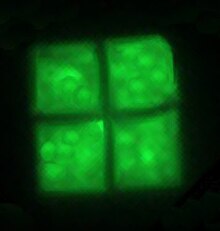| Haloquadratum | |
|---|---|

| |
| Scientific classification | |
| Domain: | |
| Kingdom: | |
| Phylum: | |
| Class: | |
| Order: | |
| Family: | |
| Genus: | Haloquadratum Burns et al. 2007
|
| Type species | |
| Haloquadratum walsbyi Burns et al. 2007
| |
| Species | |
Haloquadratum (common abbreviation: Hqr.) is a genus of archaean, belonging to the family Haloferacaceae.[1] The first species to be identified in this group, Haloquadratum walsbyi, is unusual in that its cells are shaped like square, flat boxes.[2]
This halophilic archaean, discovered in 1980 by A.E. Walsby in the Gavish Sabkha,[3] a coastal hypersaline pool (sabkha) on the Sinai Peninsula in Egypt, was not cultured until 2004.[4]
The cells typically contain polyhydroxyalkanoate (PHA) granules, as well as large numbers of refractile, gas-filled vacuoles which provide buoyancy in a watery environment and may help to position the cells to maximize light-harvesting.[5] The cells may join with others to form fragile sheets up to 40 micrometres wide.
H. walsbyi can be found anywhere in hypersaline waters.[6] When sea water evaporates, high concentration and precipitation of calcium carbonate and calcium sulfate result, leading to a hypersaline sodium chloride-rich brine. Further evaporation results in the precipitation of sodium chloride or halite, and then to a concentrated magnesium chloride brine termed bittern. During the final stage of halite formation, before magnesium chloride concentration causes the brine to become sterile, H. walsbyi flourishes and can make up 80% of the brine's biomass.
- ^ See the NCBI webpage on Haloquadratum. Data extracted from the "NCBI taxonomy resources". National Center for Biotechnology Information. Retrieved 2007-03-19.
- ^ Stoeckenius W (1 October 1981). "Walsby's square bacterium: fine structure of an orthogonal procaryote". J. Bacteriol. 148 (1): 352–60. doi:10.1128/JB.148.1.352-360.1981. PMC 216199. PMID 7287626.
- ^ Walsby, A. E. (1980). "A square bacterium". Nature. 283 (5742): 69–71. Bibcode:1980Natur.283...69W. doi:10.1038/283069a0. S2CID 4341717.
- ^ Cite error: The named reference
Burns2007was invoked but never defined (see the help page). - ^ Oren A, Pri-El N, Shapiro O, Siboni N (2006). "Buoyancy studies in natural communities of square gas-vacuolate archaea in saltern crystallizer ponds". Saline Systems. 2: 4. doi:10.1186/1746-1448-2-4. PMC 1459177. PMID 16613609.
- ^ Bolhuis H, Martín-Cuadrado AB, Rosselli R, Pašić L, Rodriguez-Valera F (July 2017). "Transcriptome analysis of Haloquadratum walsbyi: Vanity is but the surface". BMC Genomics. 18 (1) 510. doi:10.1186/s12864-017-3892-2. PMC 5496347. PMID 28673248.